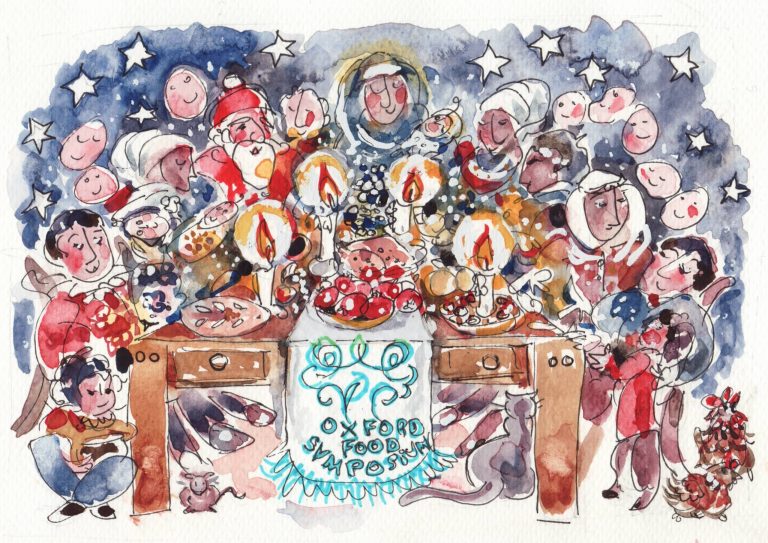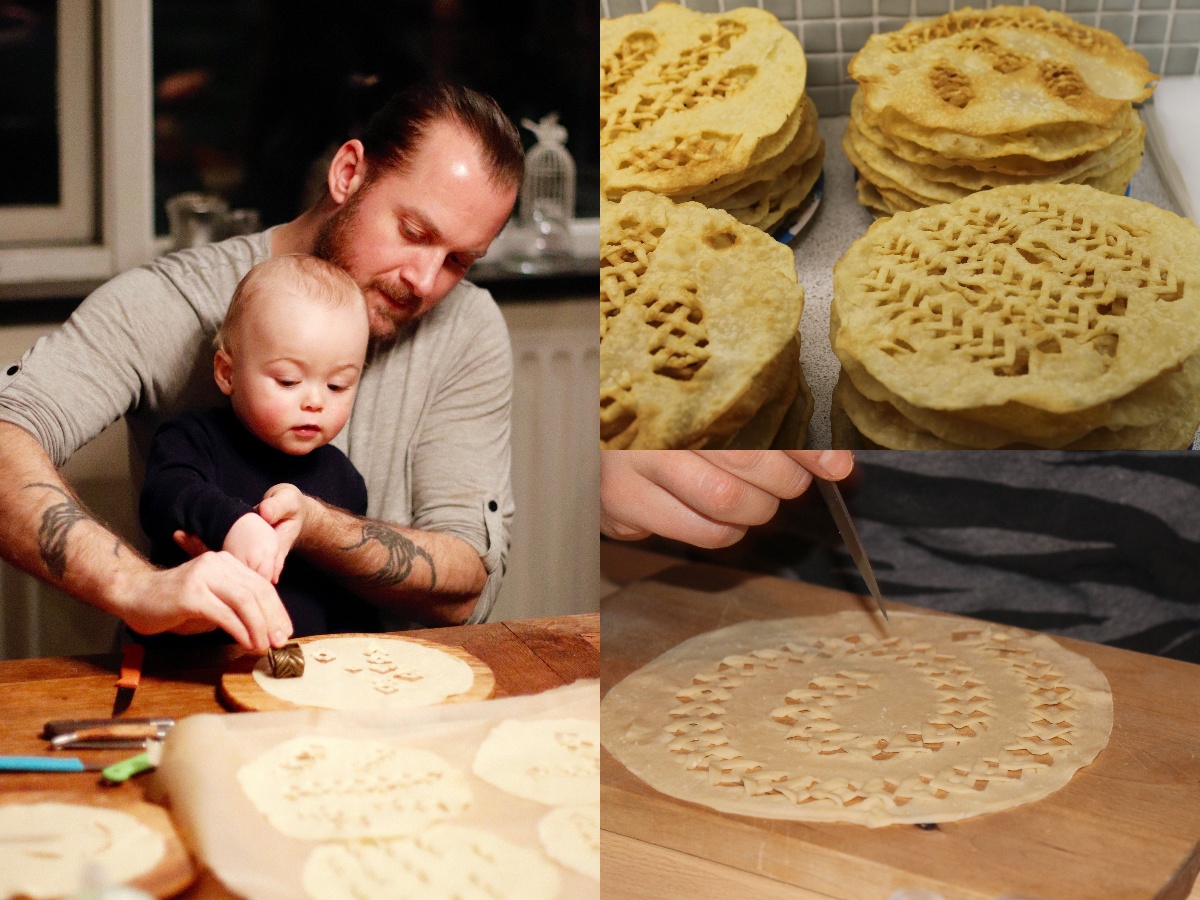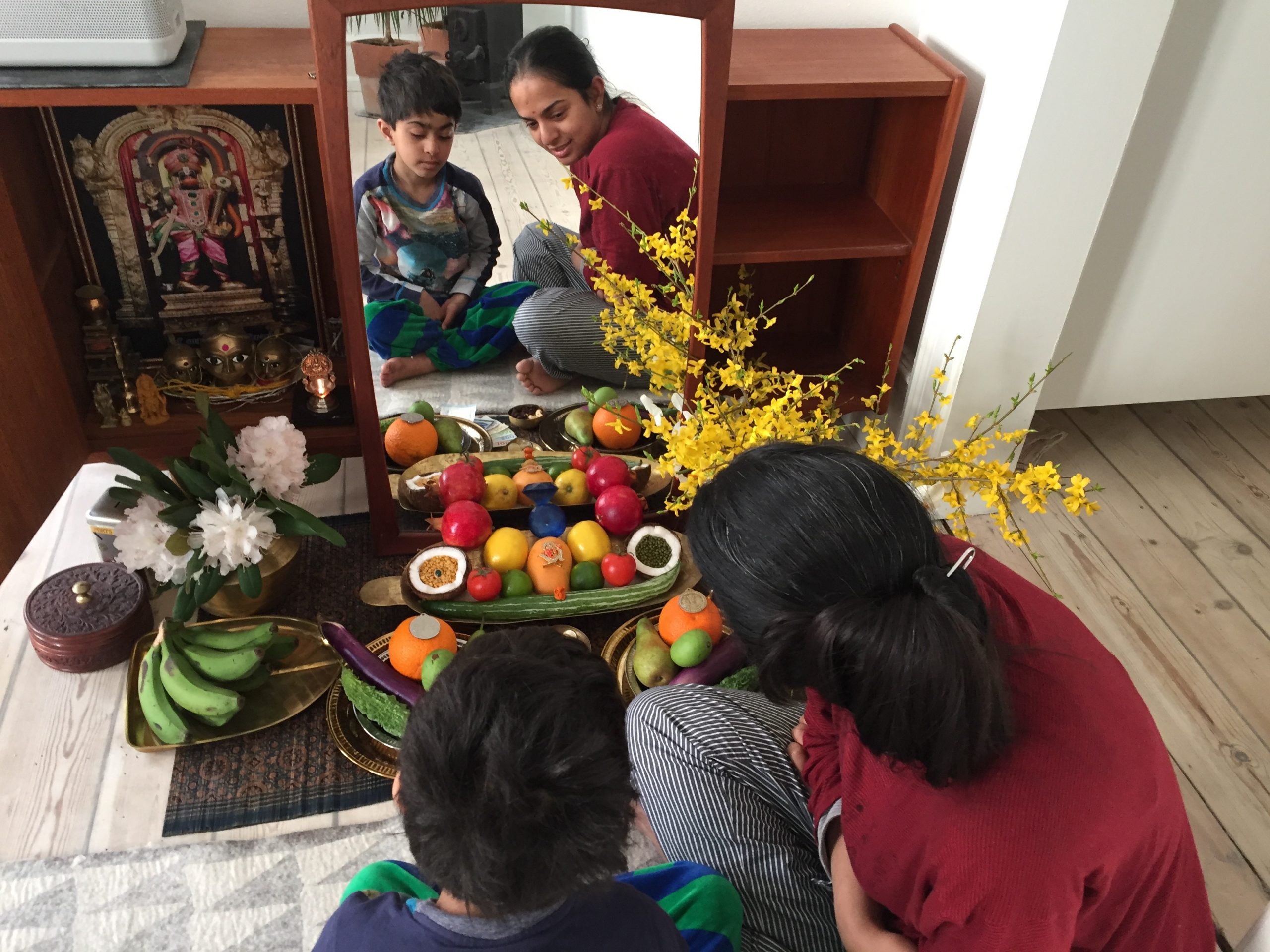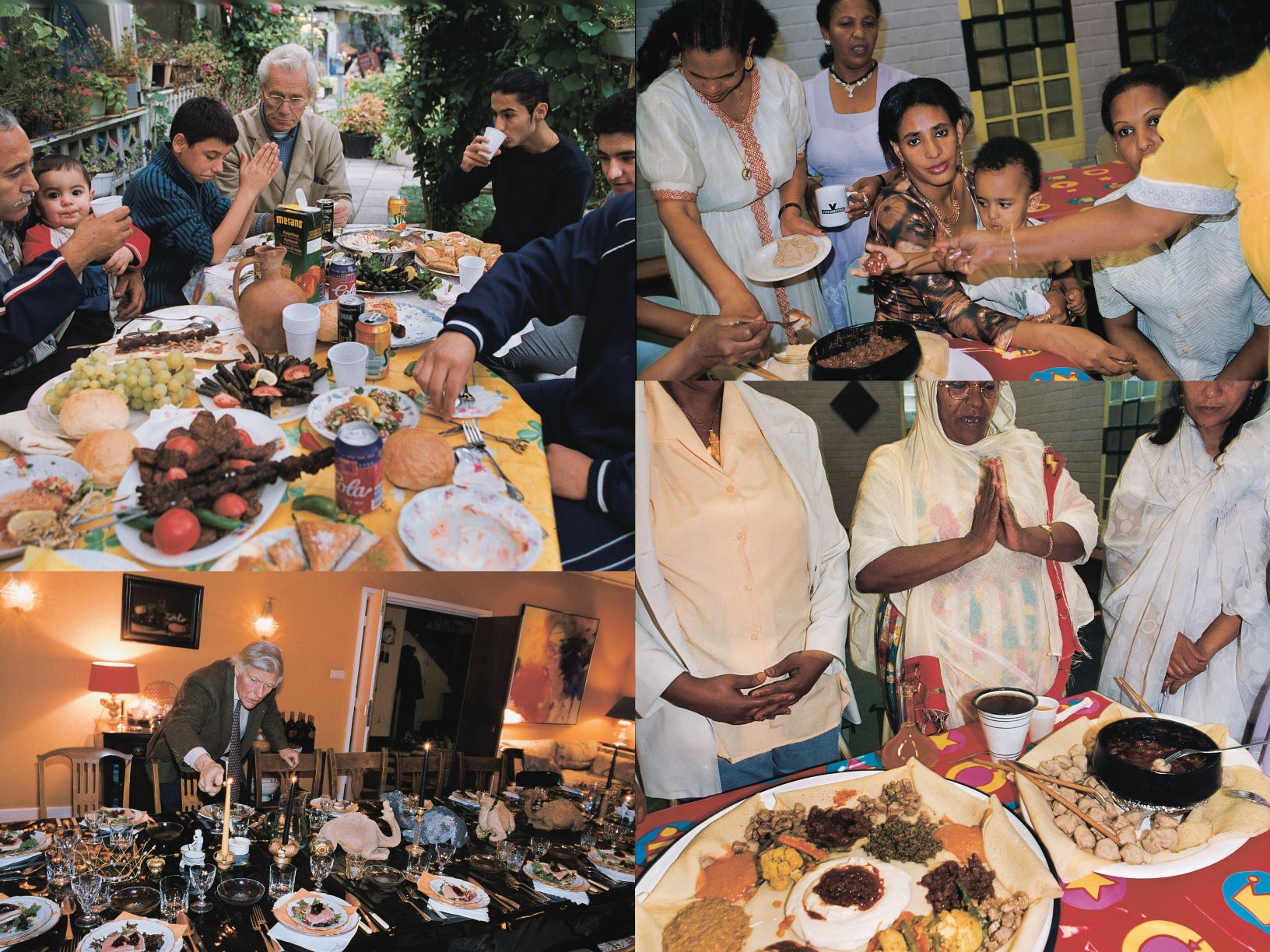
Kitchen Table No. 3 – digest from the chatline
Shared Visions: Expressions of Hope Through Food on the Table
Symposium Chair Elisabeth Luard, Nanna Rögnvaldardóttir, Priscilla Mary Işın, Priya Mani and Linda Roodenburg joined Symposium trustee Gamze İneceli to send 2020 off with a festive chat on celebrations, feasts and finding hope in times of darkness.
What follows is a rough digest of the subject-matter and chatline from the gathering on December 16th, 2020.
In Provence & Britain (Elisabeth Luard)
Elisabeth started the conversation by reminding us of how much we – fellow-inhabitants of our beautiful planet – share of the rituals and customs with which we mark important moments in our lives. Whatever the reason – religious festival, anniversary, changing year – the symbolism of what we set on the table allows us to communicate without words. At time of darkness, real or in the mind, instinct tells us to light a candle, taste sweetness, give thanks through generosity to others. Many of the threads that remind us of who we are are woven together in Provence where the river Rhone, arterial highway to the heart of Europe, meets the Mediterranean, watery pathway into the heart of Asia. On the edge of the river’s delta, in the little town of Arles with its prehistoric burial grounds and Roman amphitheatre, poet Frederic Mistral’s ethnological museum, Museon Arlaten, tells the story of these ancient shared beliefs. She continued with thoughts of Christmas pudding and mince pies: the pudding, in its original form, is a suet dumpling sweetened with dried fruit and nuts to make it special, cooked in a cloth suspended in or over what’s cooking in the boiling-pot. Mince(meat) pies included chopped meat along with dried fruit, nuts, spices and kidney-fat – suet – until the division between sweet and savoury became more marked in recent times: after the meat was lost, the suet remained.
In Iceland (Nanna Rögnvaldardottir)

Nanna remembered what Christmas meant for her as a child: candles lit in all the windows; a tree made out of a broom with green paper leaves; the scent and taste of apples which were imported and came as a gift from her grandmother. Imported fruits were never available any other time. The scent of apples is the scent of Christmas in Iceland, and light! Light and red apples! “Talking about apples, we get them year round now, but when I was a child, I only ever saw them at Christmas and for years, never understood the attraction: it was always mealy and dry.”
Both adults and children looked forward to preparing leaf-bread [crisply-fried paper-thin rounds of dough, intricately-patterned with a knife] the making of which involved the entire household or even the whole community (still does).
Then, there was the Christmas cat who was supposed to go after anyone that didn’t have a new piece of clothing for Christmas, so everyone usually got something, even if it was just a pair of stockings.
In the old days, the traditional eve-of-feast mischief-making was created by the Yule Lads – thieving rascals trying to steal food – now converted into thirteen lovable Santas who give children treats.
In Turkey (Priscilla Mary Işın)

Turkish Rooster Lollies. Photo credit: Priscilla Mary Işın
Mary spoke of the Turkish tradition of offering something sweet to welcome guests. Sweetness is also provided at funerals and on remembrance. On the 40th day of mourning, and at the date of death in the following years, the family organises the provision of “lokma” – little doughnuts dipped in syrup – to everyone in the town or village, but most especially to people who didn’t know the deceased, in return of which, a prayer is said for the departed soul.
Sweet things considered appropriate to celebration, particularly in villages and small towns, are lollipops in the shape of a rooster – herald of the dawn, bringer of light in darkness and hope in hardship – an image present in many mythologies and cultures. Gamze added:
in my childhood, a favorite lollipop was the red rooster. The fox and rabbit making peace with each other is a very old Ottoman mould, now unfortunately vanished, but while I was chatting with the gentle master who makes them, all these old traditions and stories came bubbling up. These symbols definitely need reviving. While the ones he made for us weren’t particularly flavoured, in the old days, cinnamon was the rooster-flavour, other flavours were rose, violet, lemon, bergamot and so on – now we have these only as hard candy.
In India (Priya Mani)

Vishu Kani. Photo credit: Priya Mani
Priya spoke of sweet-throwing rituals in Indian festivities similiar to those in Turkey – a physical demonstration of generosity to others as an essential ingredient of celebration.
By placing traditional food on the table you express the hope that your children will continue to cook from nostalgia: a way of remembering.
Among festive “Vishu Kani” memories from her childhood, an arrangement of ripe fruit and yellow flowers, symbols of plenty, are set in front of a mirror to double the good fortune. Arranged by the senior matron of the family, the display is kept hidden from view till the morning, when the youngest child is woken before dawn and led to the display, eyes shut, it’s still a little dark:
When you open your eyes, the very first image you see is your own reflection in the mirror surrounded by the glitter of gold jewellery and yellow fruits, telling you that the greatness of God lies within yourself.
In Rotterdam (Linda Roodenburg)

Linda gathered together all the threads through a series of images of multinational midwinter celebrations in Rotterdam, demonstrating the power of food to evoke memory and belonging. During the time she spent with migrant families in Rotterdam did she notice any similarities in food habits and ways of celebrating? “No! They were all quite different.” Such a lovely patchwork of cultures enjoying food – sharing food together is so important. Wonderful to see all of the cultures represented and people celebrating and dancing.
The universal similarities are variety, plenty, and the joy of sharing with loved ones. The similarity is the communality. Sharing food is a universal language.
From the Chatline
The Importance of Light
Light in darkness [indicates] hope for future…
We lose this dark/light distinction in cities where there is always light…
We have forgotten the magic of darkness in the West, which is why losing power is, among other things, magical…
Power-outages are one of the only times we see the contrast of how dark the world can be…
I remember a series of power cuts in the 1970s as a child – they were magical! We have forgotten about magic, period!…
In these weird times to believe in magic, it’s not only important but soothing.
Nana’s stories remind me of Gaston Bachelard’s Poetics of Space – the lovely feeling of being inside and cosy when outside it is cold and dark.
On Belonging
You do not make leaf bread by yourself – it is communal – Sense of belonging somewhere…
Making leaf bread in care homes is a great idea…
Brings to mind the making of tamales in the Southwest…
I feel I belong when working with others… Sharing memories of childhood and family equals belonging…
That’s what we are all missing isn’t it? Getting together to do things?
On Santa
Santa really distresses me. Coercing children into lying to each other in order to not reveal an adult conspiracy!
“Mass deception of children” – such a great phrase…
I still put an orange in our children’s stocking and tell them the story that my grandfather told me of having one orange all year, on Christmas Day.
The Importance of Sweetness
There are so many foods that are tied in with traditions of good life, good marriage and good luck…
Hard sugar broken over the bride’s head for a sweet, good marriage is such a lovely idea…
In Eyup, an old neighborhood in Istanbul, there were shops making sugar toys and animals…
Maybe Gamze’s red rooster lollies are no longer a special treat because children eat so much sweet stuff all year… Historically, sugar was a symbol of wealth…
The human craving for sugar is intense – hunter-gatherers will risk their lives to collect honey from high up in a tree…
Red is lucky in many cultures: pink-colored helva is served at wedding ceremonies in the Aegean.
Some Jewish traditions include having a candy to suck when you leave a graveyard, to remind you of the sweetness of the world. Also it is usual to throw candies at a bar mitzvah boy or girl after they have read their torah portion to the community in the synagogue. Sweets feature in quite a few Jewish festivals – there is a lot of sweet-throwing – hamentaschen, sufganiyot – at simchat torah.
Fast Before Feast
Could it be that we need abstinence before feast, as in the past happens before Ramadan?
In Provence on the Eve of Christmas, a fasting supper (souper maigre) precedes the Reveillon, a feast of good things traditionally served after attending Mass at midnight…
We still have fasting in Italy on Christmas Eve, when we only eat fish, vegetables, and pasta, but no meat…
I suppose the agricultural year [with its nature-imposed periods of fasting] makes the need for spring and renewed fertility much starker than in hunter-gatherer cultures.
The Value of Sharing
In Turkey, we all take turns to continuously stir the semolina when making “halva”, so that everyone has a hand in the preparation…
There’s a tradition of stirring the Christmas pudding in Britain…
We used to have big picnic parties when I was young, & the kids all took turns hand cranking the machine to make ice-cream…
It tastes better if you make it together…
In some Indian cultures, people come together to make things…[there’s] symbolic significance in the ritual of sharing stories and singing songs together…
When neighbors share food with you, there’s a tradition of returning the bowl with something else inside…This is a regular habit in Turkey with any food offered – you never return a food bowl or plate empty.
Helps to keep connections…create memories to be cherished…
Strangely, the nearest I’ve come to this sharing of food in my life was under lockdown this year – my neighbours showed up with a slice of cake.
Grains as Symbols of Renewal
Grains – rice, lentils, etc – indicate prosperity in areas where they’re not a luxury food but have symbolic value. Wheat is in the center of rituals in wheat-growing areas. Rice would be a festive food in northern countries because imported and bought with money. …[Both] grains and fruits are in the hope of a prosperous and fertility in the coming year…
Just like the egg breads of Ukraine…
Aşure aka ‘Noah’s pudding’, a wheat-berry porridge sweetened with sugar, enriched with beans,chickpeas, nuts and dried fruits (raisins, apricots, figs) flavoured with rosewater. is cooked in huge pots and distributed to neighbours, friends… Hope and symbol of prosperity for the year ahead…
On Ensuring Harvest
The end of winter, when the rains will soon come, is a time of hope; whereas in the cold north it’s the return of the sun that is the sign of coming life…
In India, anticipation of spring in the form of a display of flowers and fruit is an expression of hope, as the inclusion of neem (for health), jaggery (sweetness), pepper (spiciness), salt (signifies fear), raw mango (lemony sharpness)…
Lengthy preparation of the display is a reminder to work hard to make your wishes come true. …
The Balinese also do these arrangements for celebrations as well as temple offerings. …a beautiful tradition to celebrate bounty and the need to be thankful. …
I had a Christmas in Calcutta and our friend put candles and a petals in a copper bowl of water in front of a mirror, so now I know why …your own reflection is the mirror tells you that you are the god and god is in you.
The Significance of Surprise
In the Indian Vishu Kani, an element of surprise is delivered by keeping the fruit-flower arrangement hidden overnight….. Like waking up on Christmas day when Santa has come in the night. …
The same happens in Germany for the Christmas tree, which was only lit and revealed on Christmas Eve to open the celebration…
Exactly so – with a bell rung! …First sight, that first vision of plenty…what a wonderful way to teach kids…that food is a part of life, and life is dependent on the planet…
Priya’s arrangement demonstrates hope for a meal tomorrow…a transition to food security. …
For us it was Christmas Eve: we were sent to our room, while my parents (Christkind) decorated the tree and put out the presents and cookies. We were summoned with a bell: my father revelled in the role – he loved holidays – my mother did all the other work, but this part was his….
In Scotland, there’s a long tradition of first-footing [going from house to house as a visitor after midnight] for a slice of Black Bun (rich fruit-cake baked in a pastry-case). The hope is that your first footer is a dark-haired, dark-eyed man bearing a piece of coal for the fire [rather than a blond blue-eyed Viking fresh off his long-boat for a spot of rape and pillage]. First vision: use your right foot to enter a room.
On Celebratory Ingredients
Some people need absolutely to have the same thing every year: others are open to new rituals and foods etc…
Nutmeg is in lots of Christmas favourites, so in a way, there is some of Indonesia in all of our celebrations…
We usually do a Christmas market with my German cousins: they just sent me lebkuchen…
Usually we get trays of satsumas – the kids inhale them – but I’m not seeing them when shopping online.
We always got tangerines in our St Nicolaus Day boot – and a few nuts…
Yes – a tangerine or orange in the foot of the stocking was non-negotiable…
We experiment wildly around the dietary preferences of family and loved ones: we used to double everything at Thanksgiving: one traditional and one innovative for each of the usual dishes…
When my daughter was vegetarian, we adapted all dishes but the main. Lots of non-meat umami…
We are looking forward to our roast goose and red cabbage…
My mother makes a deeply unpleasant red cabbage every year…
I think one of the reason why Christmas food is about citrus, spice and dried fruit so much is an attempt to bring the warmth of where those things are from to the dark and cold of winter…
There are no big gatherings this year, but there is no shortage of food! The exchanges started two weeks ago. A lot of rice-cakes, fruit, and cookies have been flying in and out of the door. The thing that strikes me about Christmas dinner in the West is that it’s just about the last ritual that almost everyone engages in…
It’s why families coming together through marriage can generate trouble around the table: whose stuffing wins? When we share food together we all smell right to each other – it’s atavistic…
There are fashions in Christmas food in the UK. My parents were German refugees and for Christmas we had lebkuchen etc. They also lived in Italy, where we had panettone, which were difficult to find in 50s but easily available and traditional now.
